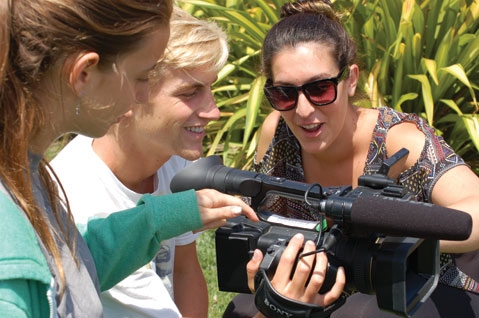Blue Horizons Equips Students to Be Documentarians
UCSB Summer Intensive Culminates in Four-Film Screening

With help from UCSB’s Coastal Fund, Summer Sessions, Carsey-Wolf Center, and Sony Pictures Entertainment, 18 aspiring UCSB filmmakers and scientists with scarce experience were transformed from everyday college students to bona fide marine documentarians.
Blue Horizons is an intensive nine-week crash course on environmental documentary filmmaking, resulting in the creation of four films that shed light on environmental issues in and around the Santa Barbara Channel. It’s a six-year-long tradition designed to throw students headfirst into the world of environmental filmmaking.
The five- to 10-minute student films will premiere at UCSB’s Pollock Theater at 7 p.m. on Friday, August 24.
“Communicating science is, nationally, a problem. To really make a difference, you have to communicate it,” said LeeAnne French, associate director of the Carsey-Wolf Center and instructor of one of the program’s three preproduction courses. “UCSB is uniquely positioned, because we have a really well-respected Film and Media Studies department and top-notch marine scientists. We’re one of the only institutions that could really combine science and film together.”
Blue Horizons aims to prime college students to turn the science behind the area’s environmental hitches into something the wider public can understand. The students broke down into groups of four to five people and produced a total of four films about sea otters, whale strikes, pelican predicaments, and people living in the Ventura riverbed.
“What I’ve realized is that applying the creative aspects of photography, filmmaking, and literary communication to influence public thinking about the environment really appeals to me,” said Mallory Smith, a human biology major at Stanford University who came to Santa Barbara this summer for the program. “Blue Horizons has been one of the most intense experiences of my life but at the same time one of the most rewarding. I think I’ve learned more this summer in this program than I have in any other quarter of college thus far, and I certainly am way more engaged with the material than I am in a normal classroom setting.”
The program proved to be an all-consuming but high-reward venture for those who enrolled. Nine weeks would hardly pass for enough time to learn the logistics of documentary filmmaking, said the students, yet in nine weeks’ time, they devoured the basics of both film production and marine science and created an informative film.
“Our time has been consumed with researching our topic, finding our story, tracking down informed and interesting interviewees, learning the art of sound and lighting, dealing with industry-grade software, working as a team, and, ultimately, piecing together all of these elements into a production that we are proud to show the Santa Barbara public,” explained Mark Romanov, a fourth-year ecology and evolution major at UCSB. “The most important thing that I learned from Blue Horizons is that a film needs to be able to organically evolve during production.”
Romanov worked with three others on a film called No Otter Zone, which aims to explain the risks of allowing otters in the otter-free area south of Point Conception.
“We hope to inform the Santa Barbara public about the controversy surrounding the removal of the ‘no otter zone,’” said Romanov. “Allowing the otters back into Southern California will ultimately affect the local shellfish industry, as otters are a prolific consumer.”
The program comprised four courses. Co-taught by Professor Richard Hutton, executive director of the Carsey-Wolf Center, and Lisa Leombruni, a communication PhD student, the environmental media course required students to deconstruct narrative films and documentaries, and then use their newfound understandings to write the treatments for their own films. Issues in Marine Conservation examined California’s marine ecosystems, the proposed approaches at managing them, and the threats to their well-being.
“The class is soup to nuts, digital video production,” said Michael Hanrahan of Environmental Media Production, the third class the students take before they start filming. “It’s a rigorous six weeks of demos, workshops, and practice.”
The final course, on advanced production work, brought the students to the field to put the past six weeks of preparation to use.
“This is crunch time,” described Hanrahan.
Of the 30-35 students who apply each year, 18 are selected by Hutton and Constance Penley, a UCSB film professor and codirector of the Carsey-Wolf Center. Although the program involved intensive film training, not all of the enrolled students hope for a Hollywood future; nearly half of this year’s documentarians are headed into science-based careers — a roster representative of the science/film fusion that Blue Horizons is at heart.
“I was attracted to the premise of combining an awareness of environmental issues with the skills needed to communicate them through filmmaking,” described Hutton about his involvement in the program. “Great documentaries do more than pass on information; they reach their audiences emotionally.”
When the films hit the big screen of the Pollock Theater, it will be the first time they are shown to an audience. After the screenings, the students answer questions onstage about their films and experiences.
“Giving audiences the opportunity to talk with the filmmakers brings the shows alive. You’re no longer passively watching,” said French. “The room is electric.”
4•1•1
The Blue Horizons documentaries screen for free this Friday, August 24 at 7 p.m. in UCSB’s Pollock Theater. For tickets and info, call (805) 893-4637 or visit carseywolf.ucsb.edu.



